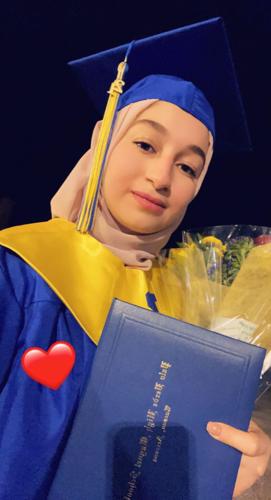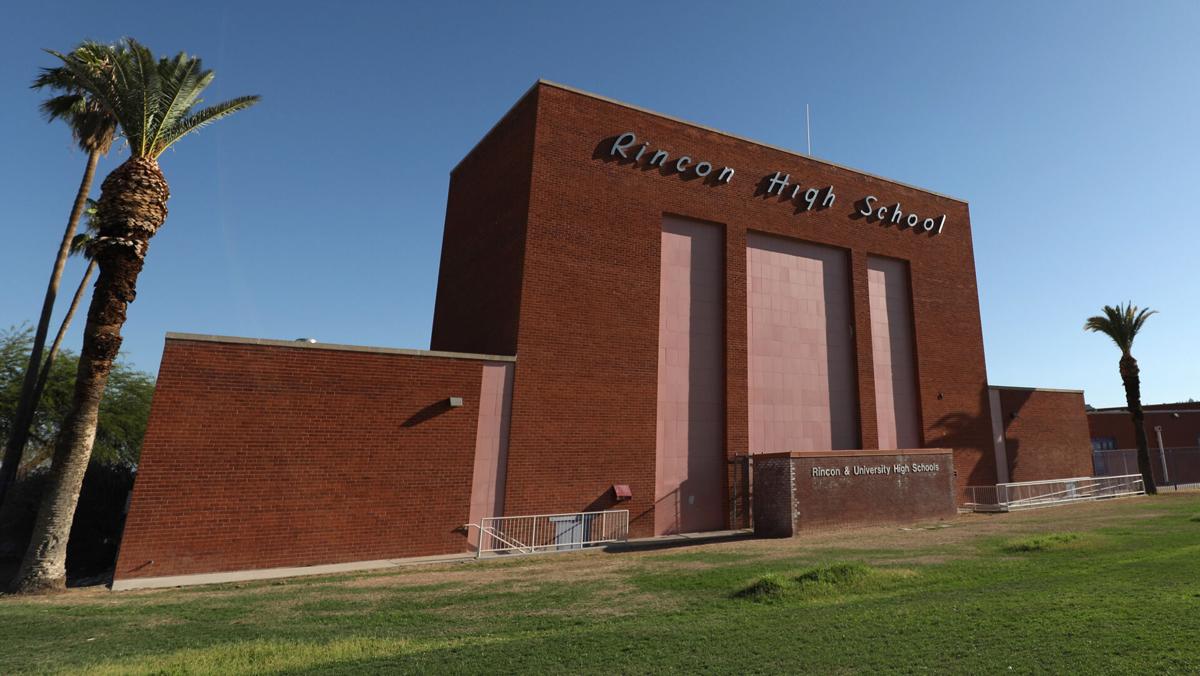Among Tucson Unified School District high schools, Catalina showed the sharpest increase, and Rincon the biggest drop, in the percentage of seniors who graduated this year compared to pre-pandemic years.
At Catalina, 82% of seniors graduated by the end of May, compared to 66% who graduated in 2019.
Rincon, on the other hand, had the biggest decrease within TUSD, with 72% of its seniors graduating this year compared to 80% in 2019.
Rincon’s percentage was also one of the lowest throughout Pima County, where most schools showed a graduation rate of 80% and above this year.
“We’re not happy with it. We’re concerned,” said Cathy Comstock, the TUSD assistant superintendent who oversees Rincon High.
Overall, TUSD showed an across-the-board average of 88% of seniors graduating this year. That number was based on the number of seniors still enrolled in the district by the last day of school; other students may have dropped out or moved away.
Additionally, that number was expected to rise a bit as senior students completed missing class credits during the summer.
English Language Learners
Comstock said that while no final determinations had been made regarding Rincon’s graduation count, she was considering two main factors.
She said those are the school’s relatively big populations of refugee students and English Language Learner (ELL) students, as well as its higher count of students with autism, who typically take a bit longer to fulfill the required credits.
During the 2021-22 school year, according to information provided by the district, Rincon and Tucson high schools had the highest number of students with autism, with 40 students enrolled at each school. Other high schools served between 10 to 20 students with autism.
Also, “Rincon is one of those schools that has a significant number of refugee students because of where the refugee housing is located,” Comstock said.
Rincon also served a total of 43 students with refugee status, 13 of whom were seniors. The school also served an additional 65 non-refugee ELL students, 12 of whom were seniors.
At the end of last school year, Rincon had a total enrollment of nearly 1,200 students, meaning those 108 in ELL made up more than 10% of the school’s student body.
Those numbers put Rincon among the list of schools with the highest number of ELL students, but not at the top. Pueblo and Cholla high schools served a total of 129 and 110 ELL students, respectively, and Tucson High tied with Rincon.
“Some of them come in and we have to teach them English first,” Comstock said of refugee students. “With our ELLs and our refugees, it sometimes takes five or maybe even six years for them to be able to get the credits that they need in order to get to graduation.”
Melissa Castillo, the associate superintendent of equity, diversity and inclusion for the Arizona Department of Education, said that while some ELL students may take more than four years to graduate from high school, there’s no such thing as “typical” patterns or experiences for that group.
“It’s very specific to the learner and the experiences and the background that they already have,” Castillo said of the students’ process to become proficient in English and graduate from high school.
But, she added, research has shown that there’s often a lower graduation rate among ELL students statewide.
“Our Latino students are graduating at a lower rate than our white students, and when you disaggregate that data, a lot of our Latino students are ELLs,” she said.
Even so, Castillo noted, there are still many success stories among ELL students.
“We also have a lot of English-learners that are really excelling in school and we’re learning from their educators and their experiences as to why, and taking those things into consideration,” she said.
Personal experience
Sara Makansi, a 19-year-old Syrian refugee student who graduated within four years from TUSD’s Palo Verde High School in May 2021, is an example of one of those success stories.
Makansi said she arrived in Tucson when she was 13 and was enrolled at Secrist Middle School, where they initially didn’t offer any services or programs for ELL students like herself.
“It was so hard. They put me in history class and biology class … and I had zero English when I first came,” she said. “Then four months after, they started an English program. … But when I really started learning English was in high school.”
Makansi said her road to English proficiency was a lot of work, noting that she had to take four English classes both her freshman and sophomore years. She was able to take a lighter workload during her junior and senior years as she improved her language skills.

Sara Makansi, a 19-year-old Syrian refugee student, graduated within four years from TUSD's Palo Verde High School in May 2021.
She spoke fondly of the educational structure for ELL students at Palo Verde, where her English teachers would combine material from other classes, such as biology and history, to help students grasp that knowledge while also practicing their English skills.
Additionally, Makansi said, her English educators would maintain constant communication with the rest of her teachers, so they were aware of her language progress and could adjust their lessons accordingly for ELL students.
“I loved Palo Verde High School, their program is perfect and the teachers there, as well,” she said, adding that it was comforting to be on the same pace as other ELL students in her class. “It was awesome. I learned so much.”
She added that some of the most helpful ELL activities included listening to a song or TV news excerpt, then filling in the blanks for what they had heard. She said the school also hosted private shows for ELL students’ families, in which the students would practice their skills by acting out a story from their English books or sharing essays they had written about their experiences at the school.
“It was really nice. I hope all the schools do the same thing,” she said, in reference to the overall ELL experience at Palo Verde.
She added those skills led her to Pima Community College her first year out of high school, and she’s already been accepted to study public health at the University of Arizona in the fall.
Credit recovery
Aside from ELL students, Comstock said there was another big factor that may contribute to Rincon’s low percentage of seniors who graduate.
She said that, while some high schools offer seven-period schedules that allow students to accumulate more credits in a year and provide more flexibility for making up credits during the regular school year, Rincon offers a slightly more restrictive six-class schedule.
That’s because Rincon shares its campus with University High School, and that restricts both schools’ abilities to house more teachers and offer additional classes.
“If they fail three or four classes, it takes four summers to even make those up, so it’s a little bit of a struggle,” she said.
But, she said most students who do not manage to graduate with their class typically return the following year to continue to work towards their diploma.
“We have students that stay on the campus, it’s not that they go away. … They stay behind until they get their credits or they age out,” Comstock said, noting that the age limit in Arizona is typically 21, though there may be some exemptions for students with autism.
She added that administrators and school staff also strongly encourage and inform students of their summer school and credit recovery options to ensure that they’re maximizing their time to help them catch up on work.
“We strive to get them their diploma. What we really want them to do is become high school graduates,” she said.
By the end of June, nearly 180 students across the TUSD high schools had managed to earn all their credits through summer courses and still graduate before the end of the 2021-2022 school year, according to information provided by Superintendent Gabriel Trujillo during the July 12 governing board meeting.
Catalina High School
As for Catalina High School, which showed one of the highest graduation rate increases compared to other high schools in Pima County, Comstock said its lower student population was a big advantage.
In 2019, according to information provided by TUSD, 66% of seniors enrolled at Catalina High School managed to earn their high school diplomas. That figure jumped to 82% this year, based on the number of students who were still enrolled at the school by the last day of classes.
Comstock said that could be attributed to strong outreach efforts school personnel took on to communicate with the student community.
“They basically reconnected with seniors once they came back to campus, provided frequent credit checks, created individual grad plans for each of the students so that they could meet their graduation requirements,” she said.
Comstock noted that while Catalina also tends to have a high count of ELL students, the overall enrollment is much smaller than Rincon’s and makes it easier for staff to build those personal connections with the students and their families.
Compared to Rincon’s nearly 1,200 students in the past year, Catalina served a much smaller body of 542 students.
She added that, unlike Rincon, students at Catalina also had the option of taking credit recovery courses during their regular instructional schedule to prevent them from falling too far behind.
Improvement efforts
Moving forward, Comstock said, the district plans to continue strong summer school efforts to help students catch up on credits, and to pay close attention to the areas in which schools may need more help.
“In the next few months, we will be working with Rincon to best determine where additional district support may be needed,” Comstock said in an emailed statement, adding that the disruptions caused by online learning could also be a strong factor in the low graduation count.
As a statewide effort to help ELL students, Castillo said the Arizona Department of Education receives federal dollars to allocate to schools throughout the state to ensure that teachers receive the proper training and schools are able to offer additional services and opportunities for families to become involved in the students’ progress.
The state has also been working to update guidelines for ELL programs based on research of effective practices, and has invested more money towards understanding the needs of ELL students and how schools can best meet those, she said.
“We know if the system doesn’t understand the needs of English learners and the communities that they’re a part of, then it’s hard to support teachers in the day-to-day practices that they need to plan for,” Castillo said.





